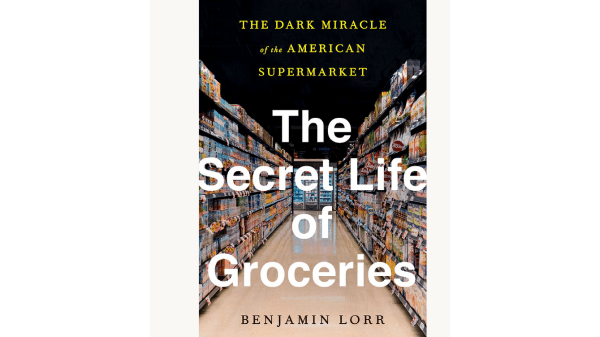It’s curious to think of what you remember a year later of a book you’ve read. Sometimes it’s only one tiny detail from an 800-page novel.
A year ago, I reviewed Benjamin Lorr’s book The Secret Life of Groceries for this column.
At this point, I mostly remember one chapter: “Distribution of Responsibility.”
It described the author’s experience in riding around with Lynne Ryles, the owner-operator of a truck: “Standing a solid six feet, two inches, large in all proportions, overweight in none, Lynne looks like she walked off some Cro-Magnon shot put team.”
Lorr draws a cold-eyed portrait of the trucker’s life: “In a car, your blind spot might be a few feet. Mine is fifty-three feet,” says Lynne. As for comfort, Lorr writes, “bunking in the cab of an eighteen-wheeler is a little like sleeping in a refrigerator, which is, of course, close to what you are doing. The reefer unit behind you blasts air at thirty-four degrees to keep the carcasses or broccoli cold.”

Then there are dogs: Lynne has two beagles. “Truckers cling to dogs with an intensity that rivals the mother-child bond,” writes Lorr. “Trucking without them would be a cruelty might not be tolerated by the driver as opposed to the cruelty that is.”
The economics are the grimmest part of this story. One run involves 1,050 miles and three stops, paying a gross of $1.16 or $1,231, “which Lynne tells me is pretty decent for a brokered load.” She also gets a $368.50 fuel surcharge. “It all sounds fairly good for two to three days of work. . . .
“Now comes the hook. First, a blizzard of deductions and 10 percent of the fuel is snatched by Cargill for the privilege of driving in their fleet. Then there is a $300 weekly payment for leasing the truck she drives.”
Other costs include lumper fees (the lumper is the one who actually unloads the truck), heavy-usage taxes, and a mandatory cleaning service after every load.
“So without any other expenses we are below $500 for the entire trip.”
What does this amount to? “Lynne estimates that she grossed $200,000 last year—that is a rough calculation based on miles driven—but that she took home less than $17,000. This for a fourteen-year veteran trucker who knows her industry inside out.”
“Last year”—whoops! I’ve made a huge mistake. I’ve been writing in the present tense. But this book was published in 2020, meaning that it was probably finished in 2019. (It takes about a year for a book to go from completed manuscript to publication.)
So I’ve been talking about the Good Old Days before the pandemic.
A recent Newsweek article suggests that the situation is unchanged since then, or worse.
Cyrus Tharpe, a hazardous-materials truck driver, writes, “This ‘essential’ job pays a garbage wage. The median annual income for a truck driver in this country is less than $40,000 a year. For many of us, 50 percent of our take-home pay immediately disappears to cover rent. Compare that to the median annual income for a cop in this country, which is $67,000 per year. That’s enough to buy a house, raise a family, and live a life. Meanwhile, truck drivers have the seventh most deadly job in America, with the highest number of fatalities per year, while cops come in twenty-second. A truck driver is 200 percent more likely than a cop to get killed on the job. Cops have unions. Most truckers don’t. Union jobs pay better and play safer.”
As in many areas, the pandemic did not create the truck driver shortage. The conditions had been seething for years, and the virus merely brought it to the boil.
My guess is that it will take the rest of this decade to resolve this issue, with countless disruptions on the way.



